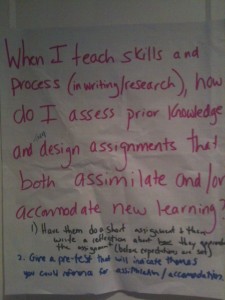This semester I have the privilege to be a participant in the Class of 1969 Teaching Scholars program here at Georgia Tech. We (a small group of faculty members, instructors, and staff from a variety of disciplines) meet once a week to discuss issues related to our seminar topic, “student engagement.” I am learning so much from our sessions, not only from the readings and discussions, but from the techniques our seminar leaders use to engage us with the topic at hand.
This week I took part in an exercise that I’m now excited to try in my class: the gallery walk.
The exercise required us to read an article on how students learn, looking at the way the brain changes when new information is stored and recalled. We were then told to think about specific challenges we face in our teaching that relate to the way that students learn new information. In groups of 5, we each wrote our challenge on a large piece of poster paper that we then stuck on the wall. Then, using different colored markers, we each wrote a practical suggestion for a way to address that problem. For example, I wrote:
“Challenge: When I teach skills and process (in writing/research), how do I assess prior knowledge and then design assignments that both “assimilate” and/or “accommodate” new learning. [1]
I received the following suggestions:
1. Have them do a short assignment and then write a reflection about how they approached the assignment (before expectations are set).
2. Give a pre-test that will indicate themes you could reference for assimilation/accommodation.
3. Have them flow chart or outline their assignments, rather than complete (d) the assignment – show how they did it or approached it.
4. Ask them to write on their approach then provide them with the ideal approach. Then, have them reflect (“critically consider”) the differences and a plan for improvement.
I then had to choose the one I found most helpful — I chose #4. While all the suggestions are good, they didn’t quite get at what I was asking, which was how can I get students to reveal their own skills and process to me in a way that accurately represents their abilities and learned habits, so that I can design assignments to refine or redefine those issues. I already do a lot of “reflection” activities before and after writing assignments, but suggestion #4 made me realize that I rarely pair those activities with a discussion of what the “ideal” approach might be.
The gallery walk was an excellent way to gather feedback from my peers in an active and engaged dynamic. I’ll definitely be using the feedback I received to my challenge, and I’ll also be looking for ways to incorporate the gallery walk into my own classes.
[1] The terms “assimilate” and “accommodate” were taken from our reading and relate to the learning process of “assimilating” new information that “fits easily with the old information” stored in the brain and the process of revising the existing information to “accommodate” new information that challenges it (18). Our text is Elizabeth F. Barkley’s Student Engagement Techniques (Wiley & Sons, 2010)

